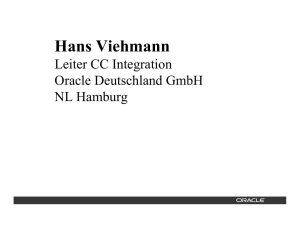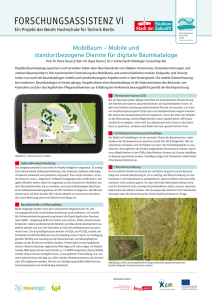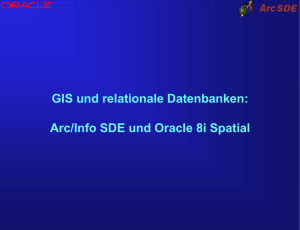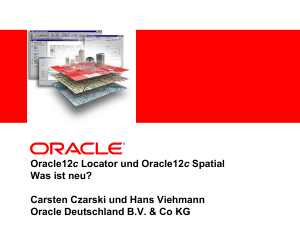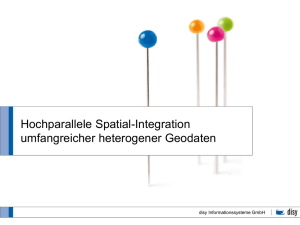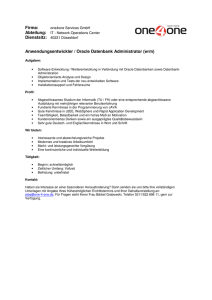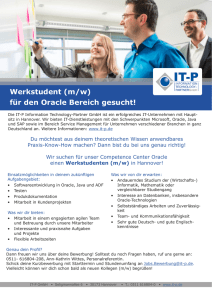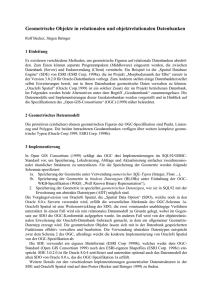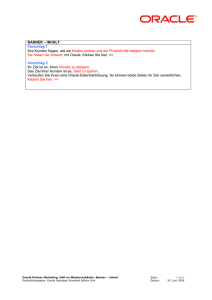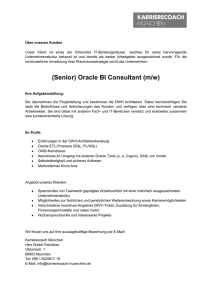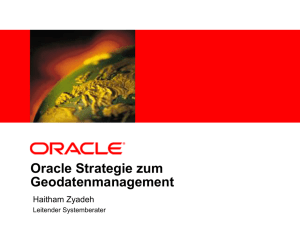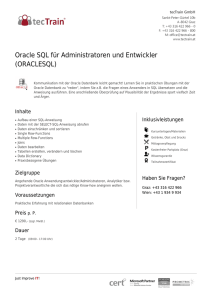Oracle Spatial: Essentials
Werbung
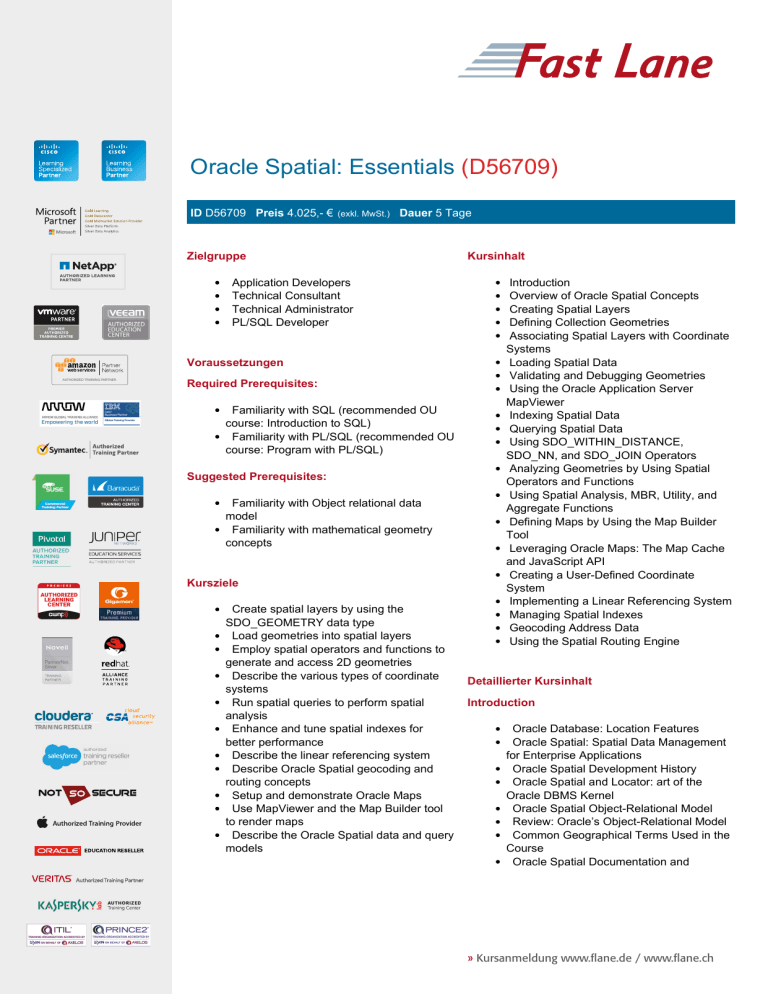
Oracle Spatial: Essentials (D56709) ID D56709 Preis 4.025,- € (exkl. MwSt.) Dauer 5 Tage Zielgruppe Application Developers Technical Consultant Technical Administrator PL/SQL Developer Voraussetzungen AUTHORIZED TRAINING PARTNER Required Prerequisites: Familiarity with SQL (recommended OU course: Introduction to SQL) Familiarity with PL/SQL (recommended OU course: Program with PL/SQL) Suggested Prerequisites: Familiarity with Object relational data model Familiarity with mathematical geometry concepts Kursziele Create spatial layers by using the SDO_GEOMETRY data type Load geometries into spatial layers Employ spatial operators and functions to generate and access 2D geometries Describe the various types of coordinate systems Run spatial queries to perform spatial analysis Enhance and tune spatial indexes for better performance Describe the linear referencing system Describe Oracle Spatial geocoding and routing concepts Setup and demonstrate Oracle Maps Use MapViewer and the Map Builder tool to render maps Describe the Oracle Spatial data and query models Kursinhalt Introduction Overview of Oracle Spatial Concepts Creating Spatial Layers Defining Collection Geometries Associating Spatial Layers with Coordinate Systems Loading Spatial Data Validating and Debugging Geometries Using the Oracle Application Server MapViewer Indexing Spatial Data Querying Spatial Data Using SDO_WITHIN_DISTANCE, SDO_NN, and SDO_JOIN Operators Analyzing Geometries by Using Spatial Operators and Functions Using Spatial Analysis, MBR, Utility, and Aggregate Functions Defining Maps by Using the Map Builder Tool Leveraging Oracle Maps: The Map Cache and JavaScript API Creating a User-Defined Coordinate System Implementing a Linear Referencing System Managing Spatial Indexes Geocoding Address Data Using the Spatial Routing Engine Detaillierter Kursinhalt Introduction Oracle Database: Location Features Oracle Spatial: Spatial Data Management for Enterprise Applications Oracle Spatial Development History Oracle Spatial and Locator: art of the Oracle DBMS Kernel Oracle Spatial Object-Relational Model Review: Oracle’s Object-Relational Model Common Geographical Terms Used in the Course Oracle Spatial Documentation and » Kursanmeldung www.flane.de / www.flane.ch Resources Overview of Oracle Spatial Concepts Define Oracle Spatial Describe Geometric Primitive Types Describe the Spatial Data Model Coordinate Systems: Concepts Explain Spatial Indexing Describe the Optimized Query Model Define Linear Referencing System Define Geocoding and Routing Creating Spatial Layers AUTHORIZED TRAINING PARTNER Describe the MDSYS Schema Spatial Native Data Type: SDO_GEOMETRY Define different types of geometry elements Construction of geometries by using the INSERT statement Manage Spatial metadata Defining Collection Geometries Define Collection geometries: Multipoint, Multiline string, and Multipolygon Describe Oriented point SDO_GEOMETRY constructors and member methods Associating Spatial Layers with Coordinate Systems Define Coordinate systems and their different types Geodetic coordinate system concepts Whole earth geometry model and tolerance Coordinate system transformations Units supported by Oracle Spatial Loading Spatial Data Different ways of loading spatial data Loading of spatial data by using SQL*Loader Export and import utilities of the Data Pump technology Load data using transportable tablespace Load data using transactional insert Use the Java shapefile converter Validating and Debugging Geometries Validation functions: SDO_GEOM.VALIDA TE_GEOMETRY_WITH_CONTEXT and SD O_GEOM.VALIDATE_LAYER_WITH_CON TEXT Geometry debugging functions: SDO_UTIL.GETVERTICES, SDO_UTIL.RECTIFY_GEOMETRY, and SDO_UTIL.EXTRACT Strategy for Geometry Validation Using the Oracle Application Server MapViewer Introduction to MapViewer Architecture of Oracle Application Server MapViewer Installation of Oracle Application Server MapViewer Use MapViewer demos Edit MapViewer Configuration File Indexing Spatial Data Concepts of R-tree indexing CREATE INDEX and the R-tree parameters Analyze, drop, and alter operations on the spatial index Use the Spatial index dictionary views Estimate R-tree index size and the resources required Querying Spatial Data Overview of the Spatial query model Overview of spatial operators, procedures, and functions Use the SDO_FILTER operator Define Spatial topological relationships Use the SDO_RELATE operator Use the SDO_GEOM.RELATE function Using SDO_WITHIN_DISTANCE, SDO_NN, and SDO_JOIN Operators Spatial queries and operators Describe the SDO_WITHIN_DISTANCE operator Describe the SDO_NN operator Spatial join by using the SDO_JOIN operator Analyzing Geometries by Using Spatial Operators and Functions » Kursanmeldung www.flane.de / www.flane.ch Calculation of the area, length, and distance between geometries Describe Arc densification and buffering Use the Spatial Boolean functions Explicit transformations with spatial functions Linear Referencing System (LRS) concepts Define LRS geometries Overview of LRS functions Implementation of an LRS Managing Spatial Indexes Using Spatial Analysis, MBR, Utility, and Aggregate Functions AUTHORIZED TRAINING PARTNER Describe some of the Spatial analysis functions Describe some of the Spatial MBR functions Describe some of the Spatial utility functions Describe some of the Spatial aggregate functions Conversion between SDO_GEOMETRY and Geography Markup Language (GML) Defining Maps by Using the Map Builder Tool Introduction to Map Builder Export and import styles Use of Map Builder to administer style, theme, and map definitions Use the Sample mapclient.jsp Define a Sample XML request with elements Open Geospatial Consortium (OGC) Web Map Service (WMS) and Oracle Workspace Manager support Oracle Spatial index partitioning Partition spatial data based on location Define function-based indexes Use transportable tablespaces Embedded spatial geometry Geocoding Address Data Geocoding concepts Oracle Spatial geocoding functions SDO_KEYWORDARRAY, SDO_GEO_ADDR, and SDO_ADDR_ARRAY types Examples using geocoding functions Geocoding service Using the Spatial Routing Engine Oracle Spatial Routing architecture Route request and response Sample RouteServer JSP Leveraging Oracle Maps: The Map Cache and JavaScript API Oracle Maps concepts Oracle Maps demo setup Maps and Faces demo More Oracle Maps demos Creating a User-Defined Coordinate System Coordinate systems concepts: Ellipsoids, Datums, and projections Geodetic or projected coordinate systems Define OGC WKT schema and EPSG Creation of a user-defined coordinate system Local coordinate system Implementing a Linear Referencing System » Kursanmeldung www.flane.de / www.flane.ch Über Fast Lane Die weltweite Fast Lane-Gruppe ist Spezialist für Technologie- und Business-Training und Beratung im Highend-Bereich. Fast Lane ist autorisierter Trainingspartner von Cisco, Microsoft, NetApp, VMware, Barracuda, AWS, Red Hat, Symantec, Veeam, Veritas und weiteren führenden Herstellern und bietet zudem eigene IT-Trainingsprogramme zu aktuellen Technologien und den wesentlichen Trends an. Herstellerübergreifende Beratungsleistungen reichen von vorbereitenden Analysen und Evaluierungen über die Konzipierung zukunftsweisender IT-Lösungen bis zum Projektmanagement und zur Umsetzung der Konzepte im Unternehmen. Training-on-the-Job und Weiterqualifizierung der zuständigen Spezialisten bei den Kunden verbinden die Kernbereiche der Fast Lane Dienstleistungen Training und Consulting. Fast Lane Services Technologie-Know-how Hersteller-Expertise Highend-Technologietraining Business- & Softskill-Training Consulting Services Sales & Business Enablement Managed Services E-Learning Remote Labs Content Development Garantietermine Onsite Training Talentprogramme • Amazon Web Services • Apple • Azeti • Barracuda • Brocade • Check Point • Cisco • Citrix • Cloudera • Davra Networks • EMC • F5 Networks • GE • Gigamon • HP • IBM • • • • • • • • • • • • • • • • Intel Juniper Kaspersky Lab Microsoft NetApp Novell Oracle Palo Alto Networks Pivotal Red Hat Relayr SUSE Symantec Veeam Veritas VMware • Big Data und Analysen • Cloud-Lösungen: Private, Public & Hybrid Cloud • Data Center & Virtualisierung • Integrierte Infrastrukturen, z.B. • FlexPod • VersaStack • Internet of Things (IoT) / Internet of Everything (IoE) • IPv6 • Netzwerkinfrastrukturen • Security • Software Defined Networking (SDN) • Unified Communications, Collaboration & Video • Wireless & Mobility Weltweite Schulungszentren Deutschland Fast Lane Institute for Knowledge Transfer GmbH Oranienburger Strasse 66 10117 Berlin Tel. +49 30 81451330 Ludwig-Erhard-Strasse 3 65760 Eschborn Tel. +49 6196 8820410 Gasstrasse 4a 22761 Hamburg Tel. +49 40 25334610 Rotebühlplatz 21 70178 Stuttgart Tel. +49 711 26345990 Hansaallee 249 40549 Düsseldorf Tel. +49 211 5382980 Am Söldnermoos 17 85399 Hallbergmoos Tel. +49 811 99819690 [email protected] / www.flane.de IT Learning Solution GmbH (ITLS ist ein Partner von Fast Lane) Johann-Krane-Weg 46 48149 Münster Tel. +49 251 95203000 [email protected] www.itlearningsolution.de Österreich ITLS GmbH (ITLS ist ein Partner von Fast Lane) Gutheil-Schoder-Gasse 7a 1100 Wien Tel. +43 1 6000 8800 [email protected] / www.itls.at Schweiz Fast Lane Institute for Knowledge Transfer (Switzerland) AG Richtistrasse 5 8304 Wallisellen (Zürich) Tel. +41 44 8325080 [email protected] / www.flane.ch • © Fast Lane Powered by TCPDF (www.tcpdf.org)
